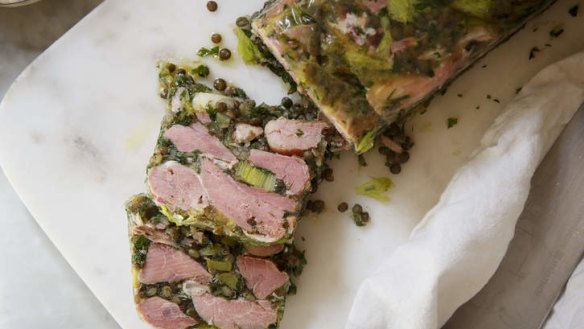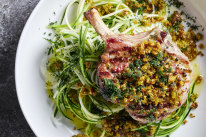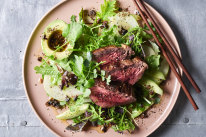Ham hock and lentil terrine

This terrine is meaty, earthy and intensely flavoured, but also laced with herbs and sparks of cornichon, caper and green peppercorn so it’s also very light and fresh. Ask your butcher to save you the meaty hock-end bones from their hams – the delicate, sticky hock meat is perfect for a terrine. Ham bones can also add so much flavour to soups and broths.
Ingredients
3 meaty hock-end ham bones (or 3–4 smoked ham hocks)
1 brown onion, quartered
1 large head garlic, cut in half
2 carrots, cut into rough chunks
2 celery sticks, cut into rough chunks
1 tbsp black peppercorns
1 fresh bay leaf5 thyme sprigs
1 bunch flat-leaf parsley, leaves picked and finely chopped, stalks reserved
2 litres good-quality chicken stock
1 large leek, trimmed
120g tiny green lentils
2 handfuls yellow celery leaves (from the celery heart)
3 leaves titanium-strength gelatine
2 purple eschalots, finely diced
2 garlic cloves, finely grated
2 sprigs tarragon, leaves picked and chopped
10 cornichons, finely sliced
2 tbsp tiny capers, well drained
1 tbsp green peppercorns, chopped
salt flakes and freshly ground black pepper
Method
1. Place the ham hocks in a large pot with the onion, garlic, carrot, celery, black peppercorns, bay leaf, thyme, parsley stalks, chicken stock and enough water to cover (if needed). Simmer very gently for about two hours. Maintain the stock level with a little water, if necessary, to keep the hocks covered.
2. Meanwhile, cook the leek in boiling, well salted water until tender. Refresh in cold water, and press as much moisture out as possible before slicing into thin rounds.
3. Simmer the lentils from a cold water start until tender, about 15 minutes. Drain and set aside at room temperature.
4. Line a 30 x 10cm terrine mould with cling film, spread the celery leaves over the base and chill until needed.
5. Once the meat is pulling away from the bones, lift the hocks out of the liquid and onto a plate. Strain the stock into a clean pot, bring to the boil and skim thoroughly. Reduce by two-thirds and then strain again – you’ll need one litre or a little more.
6. Soak the gelatine leaves in cold water for about five minutes.
7. Lift the gelatine from the water, squeezing out any excess liquid with your hands and add to the reduced stock. Stir to dissolve the gelatine and then strain the stock into a jug.
8. Pick the meat from the ham hocks, discarding the skin, tendons and excessive fat – you should have about 600 to 700 grams of meat. Add the meat to a medium bowl, keeping it in larger pieces, and add the eschalot, garlic, parsley, tarragon, cornichons, capers, green peppercorns, leek and lentils. Season with lots of freshly ground pepper. Taste for salt, it will already be reasonably salty, but it needs to be highly seasoned, as when it is chilled the intensity dies back a little.
9. Pack about half of the mix into the terrine mould, layering the largest pieces of meat lengthways first, and then pour over half the liquid. Finish with the remaining mix and pour over enough liquid to just cover. Place in the fridge overnight to set.
10. When you’re ready to serve, unmould the terrine and slice into generous slabs. Serve the terrine with fresh crusty bread, plenty of the best quality butter, dijon mustard, horseradish and lots of cornichons. The terrine will keep for seven to 10 days tightly wrapped and refrigerated.
TIPS
1. This is one of those moments (and there are many) when a friendly relationship with a good butcher really pays off: they’ll cut the bones down to size for you, and probably won’t charge you too much either.
2. For best results, prepare all the components as needed (don’t cook the hocks or lentils the day before) and layer the mix while still a little warm. This just helps to properly form the terrine and successfully marry all the flavours.
3. Try this with some freshly made pommes frites instead of bread.
Appears in these collections
The best recipes from Australia's leading chefs straight to your inbox.
Sign upFrom our partners
Similar Recipes

Grilled steak and vermicelli salad with spicy dressing and smashed cucumbers
- 30 mins - 1 hr
- Danielle Alvarez

Pepper pork cutlets with pickled zucchini salad and crispy falafel
- < 30 mins
- Jessica Brook

This Italian wedding soup is a marriage of flavours, and you’ll be making it on repeat
- 30 mins - 1 hr
- Danielle Alvarez

